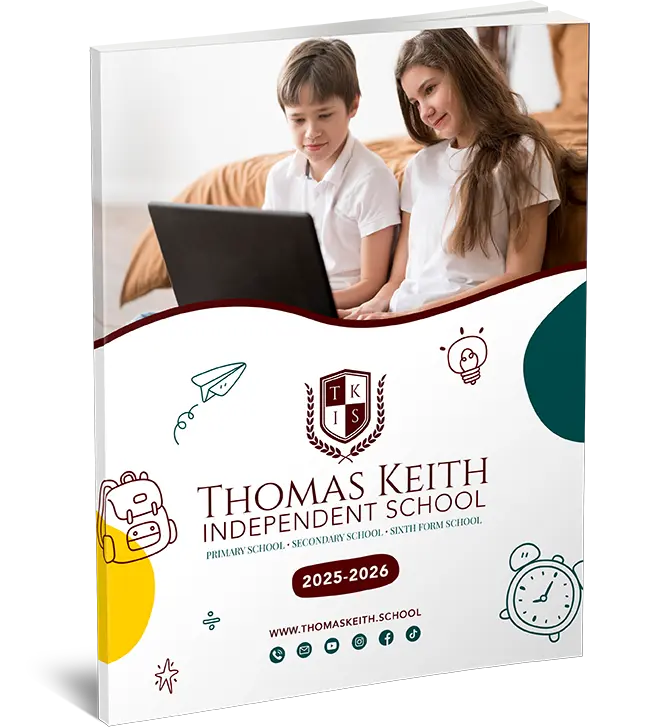Key Stages And Ages In UK Education
Key Stages And Ages In UK Education
The UK education system is divided into stages called “key stages,” each covering specific year groups and age ranges. These stages ensure children progress through a structured curriculum from primary school to the end of secondary education. Below is a breakdown of the key stages, their corresponding ages, and year groups, with an example of how Thomas Keith Online Independent School supports these stages.
![]()
Key Stage 1 (KS1)
- Age Range: 5–7 years
- Year Groups: Year 1 and Year 2
- Overview: Key Stage 1 focuses on foundational learning in subjects like English, mathematics, and science. Pupils develop reading, writing, and basic arithmetic skills.
- Example: Thomas Keith Online Independent School offers interactive lessons for KS1 students, helping them build strong early learning skills.
Key Stage 2 (KS2)
- Age Range: 7–11 years
- Year Groups: Year 3 to Year 6
- Overview: KS2 expands on the basics learned in KS1. It covers a broader range of subjects, including history, geography, and computing.
- What Year is KS2? Years 3, 4, 5, and 6.
- Example: Thomas Keith Online Independent School provides engaging online lessons, ensuring KS2 students achieve national curriculum milestones in a flexible environment.
Key Stage 3 (KS3)
- Age Range: 11–14 years
- Year Groups: Year 7 to Year 9
- Overview: KS3 introduces more advanced topics in core subjects and new subjects like foreign languages and design technology. It prepares students for their GCSE years.
- What Year is KS3? Years 7, 8, and 9.
- Example: At Thomas Keith Online Independent School, KS3 students benefit from specialised subject teachers and personalised study plans.
Key Stage 4 (KS4)
- Age Range: 14–16 years
- Year Groups: Year 10 and Year 11
- Overview: KS4 is a crucial stage where students study for their GCSEs or equivalent qualifications. Core subjects include English, maths, and science, with options for electives.
- What Year is KS4? Years 10 and 11.
- Example: Thomas Keith Online Independent School offers tailored support for GCSE preparation, providing detailed resources and revision tools.
Key Stage 5 (KS5)
- Age Range: 16–18 years
- Year Groups: Year 12 and Year 13 (Sixth Form)
- Overview: KS5 is the final stage of secondary education, focusing on A Levels or equivalent qualifications. It prepares students for university or other career paths.
- What Year is KS5? Years 12 and 13.
- Example: Thomas Keith Online Independent School enables flexible A Level study, allowing students to learn at their own pace with access to expert tutors.
Key Stage Summary Table
| Key Stage | Age Range | Year Groups | Education Stage |
| KS1 | 5–7 years | Year 1, Year 2 | Early Primary |
| KS2 | 7–11 years | Year 3–Year 6 | Primary |
| KS3 | 11–14 years | Year 7–Year 9 | Early Secondary |
| KS4 | 14–16 years | Year 10, Year 11 | GCSE |
| KS5 | 16–18 years | Year 12, Year 13 | Sixth Form (A Levels) |
![]()
Frequently Asked Questions
- What are the key stages in school?
Key stages refer to different phases of the UK curriculum, starting from primary education (KS1, KS2) to secondary education (KS3, KS4) and post-16 education (KS5). - What age is Key Stage 2?
Key Stage 2 is for children aged 7–11, covering Years 3 to 6. - What year is Key Stage 3?
Key Stage 3 includes Years 7, 8, and 9 for children aged 11–14. - What is Key Stage 5?
Key Stage 5 includes Sixth Form (Years 12 and 13) for students aged 16–18, focusing on A Levels or equivalent qualifications. - How does Thomas Keith Online Independent School support key stages?
Thomas Keith Online Independent School offers tailored online lessons for all key stages, enabling students to learn flexibly while achieving curriculum goals.




